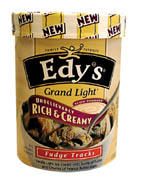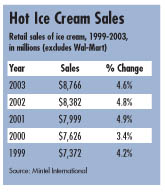
The U.S. ice cream market grew 24% between 1998 and 2003, as manufacturers aggressively launched new products and extensions to existing product lines. However, the market is driven by children, and the Census Bureau projections of declining youth populations through 2010 will force manufacturers to develop products attractive to indulging adults.
According to Mintel International's (Chicago) “The U.S. Ice Cream Market” report, ice cream is loved universally. The market grew nearly 24% between 1998 and 2003, not surprising considering 93% of all households surveyed consume ice cream products. Yet, households with children are lead consumers of ice cream, with 34% of such households consuming four or more quarts of ice cream per month, compared to 20% of households without children. Frozen novelties were 20% more likely to be purchased by households with children than those without.
Continued growth of ice cream sales demands nearly constant innovation and a close watch on the marketplace. The buzzword in the early 1990s was “healthful”; manufacturers had to devise products with lower fat and sugar content. When demand for healthier ice cream products eroded in the middle of the decade, manufacturers increased the offerings of indulgent, super-premium products and met with good results. Now, consumers are seeking more-healthful choices once again, and several manufacturers, including market leaders such as Good Humor-Breyers (Green Bay, Wis.) and Dreyer's (Oakland, Calif.), have developed new versions of their products to accommodate those consumers. However, at the same time, sales of premium and super-premium products continue to accelerate, as consumers sacrifice more-healthful eating for sumptuous flavor.
While basic varieties lead sales in the ice cream category, Mintel found other ice cream products, such as frozen novelties, frozen yogurt or tofu, and sherbet-type products are growing at a faster rate.

The Novelty of it All
Ice cream itself accounts for 61.4% of the market, with sales having increased 21% between 1998 and 2003. However, other segments experienced more rapid growth. Frozen novelties, which ranked second in the market, grew over 35% during that time period, while sherbet products grew nearly 17%. The only segment showing a decline was frozen yogurt and tofu, with sales falling nearly 17% between 1998 and 2003. (Actually, sales steadily declined until 2001 and then grew 8%, although sales in the category still dipped.)Consumer preferences vary noticeably according to age and gender, as consumer research indicated households with children and African-American households reported eating more types of ice cream products as well as eating more servings of ice cream over a 30-day time period. As kids grow, they begin to differentiate by gender in their ice cream choices. Teen girls seek out healthier options like frozen yogurt, while teen boys stay true to frozen novelty treats.
Preferences become habits as consumers reach adulthood. The majority of adults prefer the same few flavors each time they purchase, and over a third surveyed agree that too many flavors are available in the market, showing that a wide variety appeals mostly to kids.
Another challenge facing ice cream manufacturers comes from ice cream parlors and restaurants. Consumers aged 18-24 prefer to eat ice cream at shops like Baskin Robbins (Randolph, Mass.) or Ben & Jerry's (South Burlington, Vt.) rather than at home. The brand of ice cream clearly is more important to some: females, consumers over the age of 45, African-Americans and Hispanics report the brand is the most important determining factor in what ice cream to purchase. Because of the expanding number of Americans over 45 (thanks to the aging Baby Boomer population) and the increasing proportion of African-Americans and Hispanic-Americans, manufacturers will need to aggressively pursue these loyal customers.
Four major manufacturers hold 40% of the market: Unilever (Englewood Cliffs, N.J.), Ice Cream Partners USA (San Ramon, Calif.), Dreyers Ice Cream and Blue Bell Creameries (Brenham, Texas). Market leader Unilever has some of the top brands in this market, including Good Humor-Breyers and Ben & Jerry's, but faces strong competition from second-ranked Dreyers, which acquired the Nestlè USA line of ice cream products in June 2003. Private label accounted for nearly 18% of sales, as supermarkets and mass merchandisers caught on to the value of ice cream sales. The remaining 40% of sales are from regional and local companies.
Sugar Highs
The future for ice cream looks bright for such a mature market, with sales projected to grow 7% in constant prices from 2003 to 2008. Factors influencing this growth include trends toward both super-premium products and low-calorie, low-sugar and low-carb products. Also, manufacturers of frozen novelty products are focusing on adults, expected to yield the highest growth rates. Fluctuations will occur depending on consumer interest; if healthy products continue to generate sales, manufacturers will continue to develop them, but sales of premium and super-premium products will increase as well.For more information on the report, “The U.S. Ice Cream Market,” contact Mintel International Group Ltd., 213 West Institute Place, Suite 208; Chicago, IL 60610; phone, 312-932-0400.